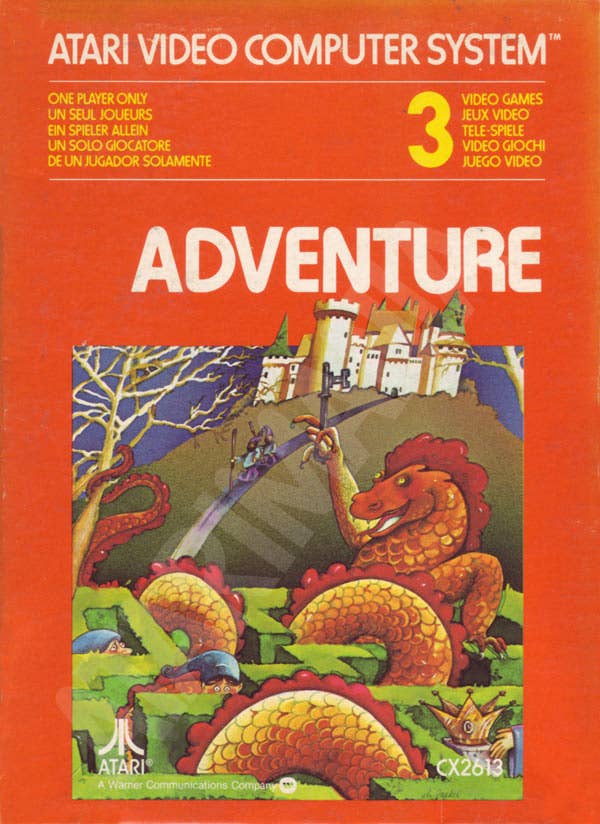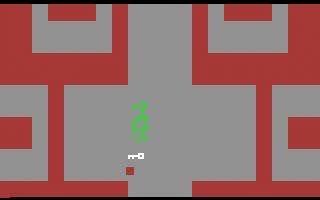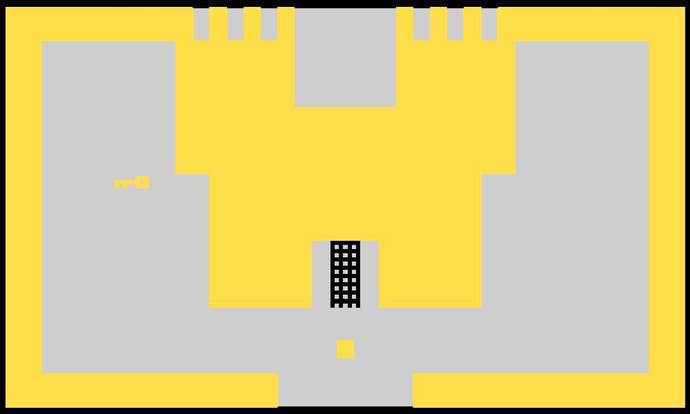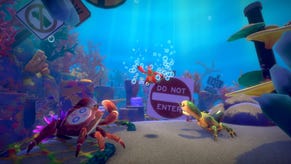"Could they fire me? No!" The Warren Robinett Interview
The creator of the very first action adventure explains how he produced the game - and why he made the first gaming Easter Egg.
This article first appeared on USgamer, a partner publication of VG247. Some content, such as this article, has been migrated to VG247 for posterity after USgamer's closure - but it has not been edited or further vetted by the VG247 team.
Pop quiz. What game was the very first action adventure? If you answered Adventure on the Atari 2600, then congratulations, you know your computer game history. Why am I talking about it? Because I recently sat down with the game's creator, Warren Robinett, to talk with him about how he created this seminal title.
I start, logically enough, at the very beginning. When did Warren first encounter a computer?
"I was born in 1951. When I was in high school I saw my first computer. My math teacher introduced me to it. It wasn't a particularly lengthy or detailed encounter, but that was the first time I wrote a program. It'd write a program, and it would get sent it off to a University in Missouri, and I'd get the results a week later.
"However, I went to summer math camp sponsored by the US National Science Foundation when I was 16 with about two dozen other high school students. I studied math four to six hours a day, and lived in a dormitory – it felt like being a University student. That really set my path. Computers and mathematics are pretty closely related, although I think some people might argue against that. But I think the logical thinking part is certainly common."

What about computer games? When did you first play one?
Warren thinks for a few moments before answering. "I first played a computer game when I saw one at an airport when my father was taking me there on my way back to college in the very early 70's. It was a stand up coin-op maze game. That stuck in my memory, because it was something new."
"I went to Rice University in Houston as an undergraduate and studied electrical engineering and math – and a lot of other things. There was no computer science department at the time, but I took a lot of programming courses, and also art courses. I actually ended up with a composite Major that I got to give a title to: Computer Applications to Language and Art. How's that for drawing a big, wide circle around everything. It could describe the 21st century, couldn't it?"
"Then after a year of working, I went to graduate school at Computer Science at the University of California at Berkeley and so I got a really concentrated dose of computer science. So it was through school that I got into computers."

"I learned several different programming languages at the time – PL-1, APL. C didn't really exist yet when I was at Rice. At least it wasn't widely known. However, I was lucky enough when I was at Berkeley – I got to take a course from Ken Thompson, the co-inventor of UNIX and C. So I learned C from the fountainhead – the inventor. He required us to use C in his course called Operating Systems."
"Ken Thompson had his own look back then, and he still has the same look today, except greyer. He was pretty much bald on top and had long hair at the back. He didn't look like any of the professors at Berkeley. He was just there on a one-year stopover. Professors sort of have a certain look, if you know what I'm saying, but Thompson didn't have that look. He was quite interested in space. He just talked about it and knew about it, but he was most interested in chess. He later developed a program called Bell that was the (computer) world chess champion. But at the time, when he brought UNIX to Berkeley, the lowest priority job that would be run if nobody was doing anything was solving all the Rock and King endgames. So he had a chess program running to soak up the unused cycles. Anyway, we're sitting in class one day and Ken Thompson writes a number on the blackboard – 2 to the 37th power. He's talking about a disk drive that had been proposed – this was back when a megabyte was a lot – and he says this hypothetical disk drive that somebody was supposedly working on was going to have a whole lot more than a megabyte of storage. Ken looks up at the class and says, "I hope you appreciate how big a number that is." I piped up and said, "the number of peanuts that would fill the Milky Way." The class roared, but Thompson didn't crack a smile. He just rolled his eyes and he thought for a second and said, "the number of stars in the Milky Way"."
"And it's true. 2 to the 37 is really close to a hundred billion, which is the number of stars in the Milky Way. So he didn't laugh at my joke, and analyzed what I said and nailed it. The pretty girl next to me laughed, though," says Warren with a grin.
When did you first see Colossal Cave adventure?
"Moving the clock forward a few years. I'd quit graduate school and gotten a job at Atari, and I was working on my first Atari 2600 game called Slot Racers. Back then, if you were an Atari 2600 programmer, you got to choose what the game was about, write the program, do the graphics, do the sounds, figure out how the gameplay worked, test it out on kids, and decide when it was finished and was good enough to release. Basically, do every single thing. So when you were finishing one game, you needed to be thinking about what to do next. I lived in a group house with five or six people, and one of my housemates, Julius Smith, took me over to where he worked at Stanford AI labs, and I played the original text adventure Colossal Cave, by Willie Crowther and Don Woods. I played it for three or four hours, and I thought it was really cool."
"But I also thought – I could do this as a video game. A pretty big transformation was required, however. Crowther and Woods had created a text adventure only – there were no graphics at all. Everything was described, and you could type in "take the lamp, take the keys, go south" – you know how it works. It would describe where you were, and you could pick up objects and carry them around and you'd encounter obstacles, and you could use objects to get past them. So how could I turn that into a video game where you're using shapes to represent those things instead of words? And how would you take the joystick with one button to control an adventure game? That was the problem I had to solve."
"I did have an idea right off the bat in terms of how to do it, because the 2600 had five little movable sprites and one background. The very first question is how do you represent a room? So I decided you'd see one room at a time on the screen, and I'd use the background provided by the 2600 called the playfield to make some sort of background representation. I quite quickly decided that I'd make mazes plus one representation of a castle, which I repeated three times. The walls of the maze would block your motion."
"Another question is how do you represent where you are in the game world? On the text game you were just in a room – but you didn't really have a position within that room. But in a video game you normally have some kind of shape you control with a joystick, so it was pretty obvious I needed a shape – these days called an avatar. So I used a little square as an avatar. The graphics resources are really, really limited on a 2600, so I wanted to save my two high-resolution sprites for objects. So I used what was essentially the "ball" sprite as an avatar, leaving the so-called "player" sprites – the high resolution ones – for use as objects. At first, I didn't have any plans to use the other two "missile" sprites, but I later ended up using them as side walls. And I used the playfield as the maze or room."

"That was actually a reasonable plan to display a room and what was in it. The objects in the room would be displayed as little icons using the hardware sprites. The other thing I needed to figure out was how to represent the network of rooms – the game world. Well, my idea was if you drove your avatar off the edge of the screen, you'd pop into the "adjacent" room, but entering from the other side. Nobody had ever seen anything like that before, but they understood it pretty quickly."
What influenced you during this decision-making?
"All of the early Atari games had been influences. I'd seen Combat. I didn't just see it - I was given the source code for that during my first day at work. Dave Plane was working on a game called Outlaw that was two cowboys shooting at each other while hiding behind cacti and things. Larry Kaplan had done Air Sea Battle that had little planes flying around the screen. Al Miller was working on a basketball game that had an interesting AI algorithm in the one-player mode – and a really ugly, blocky player and basketball court."
"I didn't play them much. I wasn't much of a gamer – and I'm still not. The games I play are games like chess and bridge. Growing up I read a lot of comics. Getting a little bit ahead of the story – I was told at one point to turn Adventure into a game about Superman. Well, I knew all about Superman, so I would have been a good person to do it. But I didn't want to do it. I wriggled out of that assignment and somebody agreed to take my code and make Superman out of it."
"There were some political obstacles to creating Adventure and getting it published. First of all, after I'd decided I was going to do an adventure game on Atari 2600, my boss wasn't very imaginative, and when he heard what I was trying to do, he said that he knew it took 100k to do Colossal Cave on a mainframe, and we had only 2k or 4k on the 2600. So he said it was impossible, and I shouldn’t even work on it."
"But I already had an idea how I was going to do it, and I didn't like this guy anyway. He just didn't understand how Atari worked. He was a little bit older and had worked at Lockheed the aircraft company, and yes engineers should do what they're told if they’re building an airplane. But these were video games and each young software engineer was coming up with his own ideas – and this is how Atari worked. So I ignored him, and worked on it in secret for a month and produced a prototype that showed you could do it within the memory limitations. Was he happy then? Hell no! He was mad that I'd defied him."
"Fortunately he couldn't fire me, because I'd shown it to other people at Atari, and people in the marketing department liked it, so they wanted me to keep working on it. However, they told me to keep the rooms and objects, but turn it into a room about Superman. That's because Atari's parent corporation Warner Communications owned the rights to the first Superman movie that was coming out later in 1979, and they wanted a game to market at the same time. But I thought I had a good idea, and I thought it had possibilities. And so every time this came up – we had a meeting every couple of weeks – I'd say I'd do if I have to, but I didn't want to. About the fourth time I said that, one of my fellow designers, John Dunn, said that he'd take over my code and make the Superman game."
"George, my boss, was once again p**sed off because, yet again, I'd not done what I'd been told to do. In other words, I had to fight to get to execute my idea."

"Once I'd made the feasibility demonstration, I had another problem. Adventure wasn't a particularly interesting game. I'd proven you could do it within 4k, but it only had half a dozen rooms and one castle and one key and a dragon that chased you around. You could pick up objects, but there were only two objects, and the dragon didn't do anything when it got to you other than buzz around you like an irritating fly. But it had proved its point about a multi-screen game world and the objects that you could pick up. It had enough promise that the marketing people could see that it was different. Most of the games at that time were only one screen. Games like Combat had just one screen. So expanding the game world beyond one screen was a pretty big step."
"Because I had to fight to even get to work on it and make it on the theme that I wanted, I was kind of puzzled what to do for about four months. It was a boring game as it stood, and I just didn't know how to make it more interesting. So I stopped working on it for a few months while I figured out how to complete it. Luckily it wasn't on any schedule, and nobody was pressuring me to finish it. George just hoped that it was going to go away."
"The original idea was a grand vision – Hey! I can turn this text adventure into a video game. But to make it into something fun, it wasn't just one more grand idea. It was like eight or ten little ideas that would fit into the programming space that I had left. That required inventing more objects and creatures that were interesting. I figured out how to make the dragon more interesting – if he caught you, he'd eat you. Then once he could eat you, I needed to figure out a way to bring you back to life, which was flipping a button on the console to reincarnate your avatar. However, if the dragon just kept chasing you around and eating you and eating you, that still wasn't particularly exciting. So that's when I came up with the idea of a sword that you could use to kill the dragon. And that was quite a good balance. Sometimes when he was chasing you and even if you had the sword he might eat you. Sometimes you'd kill him if you had the sword. If you didn’t have a sword you'd have a problem. Occasionally you could escape from the dragon, particularly if you were in a maze, but that was balanced. The dragon was pretty good at that point – and I liked it enough to make three copies of him. That was efficient programming-wise because I used three calls to the same subroutines."
"The magnet was interesting. That was created in response to a bug the game had. If the player hit the button at the wrong time you could drop a key into a wall and you couldn't ever get it out. If you dropped the black key into the wall before opening the black castle, that was it, you were screwed. You had to reset the game. I had to do something, so I had an idea to invent a tool object that would suck things out of a wall or whatever. That was a good solution. I didn't waste any memory space fixing the problem – I spent the memory making an interesting object that solved the problem."
Speaking of bugs. How did you playtest the game?
"Playtesting the game at Atari was interesting. Some of the people at Atari who weren't game designers, like Steve Harding who wrote all the manuals, for example. They liked playing the games while they were under development and would give feedback. When I went back home on vacation, I'd let my siblings and my cousins play the game. But there was no real formal playtesting. There was no real formal anything at Atari. Larry Kaplan was the manager of the game developers when I first started, and he said, "your job is to design games, now go design one," and he threw the listing for Combat on my desk. That was it."
"Before then I had a job in Houston working for Western Geophysical in the navigation department, keeping track of where the boats that made the boom, boom, boom noises out in the ocean were. They detected sounds bouncing off the strata under the ocean so they'd know where to drill for oil."How did you get the job at Atari?
"I showed up at the front door of Atari and filled out a job application and wrote a little essay about why I'd be the perfect person for them to hire. I'd studied computer graphics as a student, and I'd been taught to program. I had a masters in computer science, with computer graphics as a specialty. They bought it."
How does it feel to be a pioneer?
"I've had an interesting life and an interesting career. I didn't make much money at Atari – I didn't get any royalties. I didn't even get any recognition, or pats on the back, or bonus or anything. They didn't treat us too well."
Is that why you put the famous Easter Egg into Adventure?
"Back then I called it my signature. My first game Slot Racers had been released the previous year, the box said "Slot Racers, by Atari." So it was quite obvious when Adventure came out in 1979 it was going to say "Adventure, by Atari." Yet I'd done everything. I had the idea – at least to convert it to a video game. Wrote the program. Did the graphics. Sound. Gameplay. So, I decided I'd hide my name in the game in a really hard to get to place and not tell anybody. Let Atari manufacture a few hundred thousand cartridges and ship them all over the world, and then… I wasn't sure if anyone was going to find it. It was pretty hard to get into this little place."
"But some kids made some maps of the entire game world, and at least a few kids found it on their own. When you did get the grey dot and take it to the right place and get into the secret room – that's when you'd see what I'd written: "Created by Warren Robinett"."
"The manager of Atari who was in charge at the point of when it was discovered, said "it's kind of cool to have surprises hidden in video games. It's like on Easter morning when you go searching for Easter eggs under the bushes." He used it to mean "hidden surprise"."
"There was nothing they could really do about it. They couldn't take any royalties away from me, because I didn't have any. Could they fire me? No! I didn't work there anymore," says Warren with a chuckle.





.jpg?width=291&height=164&fit=crop&quality=80&format=jpg&auto=webp)


